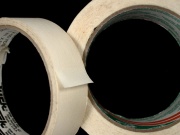Difference between revisions of "Masking tape"
Jump to navigation
Jump to search
(username removed) |
|||
| (2 intermediate revisions by one other user not shown) | |||
| Line 2: | Line 2: | ||
== Description == | == Description == | ||
| − | A pressure-sensitive tape developed in 1925 by 3M to help define lines during the spray painting of two-tone automobiles. Masking tape is composed of a creped strip of [ | + | A pressure-sensitive tape developed in 1925 by 3M to help define lines during the spray painting of two-tone automobiles. Masking tape is composed of a creped strip of [[kraft%20paper|kraft paper]] that has an [[adhesive|adhesive]] coating on one side. Originally a rubber-based adhesive was used, but most masking tapes now have an acrylic adhesive. In addition to paint applications, masking tape has been used for binding, sealing and mending. Masking tape is designed to remove cleanly from a surface with no damage or residue, but it can be difficult to remove if left on for more than a few days. |
== Synonyms and Related Terms == | == Synonyms and Related Terms == | ||
| Line 8: | Line 8: | ||
ruban-cache (Fr.); ruban protecteur (Fr.); bande-cache (Fr.); | ruban-cache (Fr.); ruban protecteur (Fr.); bande-cache (Fr.); | ||
| − | == | + | ==Resources and Citations== |
* Pam Hatchfield, ''Pollutants in the Museum Environment'', Archetype Press, London, 2002 | * Pam Hatchfield, ''Pollutants in the Museum Environment'', Archetype Press, London, 2002 | ||
| Line 22: | Line 22: | ||
* ''The American Heritage Dictionary'' or ''Encarta'', via Microsoft Bookshelf 98, Microsoft Corp., 1998 | * ''The American Heritage Dictionary'' or ''Encarta'', via Microsoft Bookshelf 98, Microsoft Corp., 1998 | ||
| − | * Art and Architecture Thesaurus Online, | + | * Art and Architecture Thesaurus Online, https://www.getty.edu/research/tools/vocabulary/aat/, J. Paul Getty Trust, Los Angeles, 2000 |
[[Category:Materials database]] | [[Category:Materials database]] | ||
Latest revision as of 12:49, 17 October 2022
Description
A pressure-sensitive tape developed in 1925 by 3M to help define lines during the spray painting of two-tone automobiles. Masking tape is composed of a creped strip of Kraft paper that has an Adhesive coating on one side. Originally a rubber-based adhesive was used, but most masking tapes now have an acrylic adhesive. In addition to paint applications, masking tape has been used for binding, sealing and mending. Masking tape is designed to remove cleanly from a surface with no damage or residue, but it can be difficult to remove if left on for more than a few days.
Synonyms and Related Terms
ruban-cache (Fr.); ruban protecteur (Fr.); bande-cache (Fr.);
Resources and Citations
- Pam Hatchfield, Pollutants in the Museum Environment, Archetype Press, London, 2002
- Ceramics and Glass Conservation Section, List of Workshop Materials, The British Museum, London
- The Dictionary of Paper, American Paper Institute, New York, Fourth Edition, 1980
- Random House, Webster's Encyclopedic Unabridged Dictionary of the English Language, Grammercy Book, New York, 1997
- A Glossary of Paper Conservation Terms, Margaret Ellis (ed.), Conservation Center of the Institute of Fine Arts, New York City, 1998
- The American Heritage Dictionary or Encarta, via Microsoft Bookshelf 98, Microsoft Corp., 1998
- Art and Architecture Thesaurus Online, https://www.getty.edu/research/tools/vocabulary/aat/, J. Paul Getty Trust, Los Angeles, 2000
